Themed collection Future Applications and Techniques using Porous Organic Polymers

Porous organic polymers in solar cells
Porous organic polymers (POPs) are unique materials for solar cells. From photoactive layer to charge transporting layer, this review discuss the challenges and opportunities for POPs presence in organic, perovskite, and dye-sensitized solar cells.

Chem. Soc. Rev., 2022,51, 4465-4483
https://doi.org/10.1039/D2CS00123C
Porous organic polymers for high-performance supercapacitors
This review summarizes recent advances and design strategies of porous organic polymers as efficient electrode materials for high-performance supercapacitors.
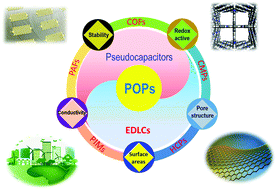
Chem. Soc. Rev., 2022,51, 3181-3225
https://doi.org/10.1039/D2CS00065B
Porous organic polymers for light-driven organic transformations
Porous organic polymers (POPs), with their high specific surface area, low density, good stability, uniform pore size, structural versatility, and designability, have recently emerged as a powerful platform of heterogeneous photocatalysis.

Chem. Soc. Rev., 2022,51, 2444-2490
https://doi.org/10.1039/D1CS00808K
Porous organic polymers as a platform for sensing applications
Sensing analysis is significantly important for human health and environmental safety. In this review, POPs used as platforms for various sensing applications have been summarized and discussed.

Chem. Soc. Rev., 2022,51, 2031-2080
https://doi.org/10.1039/D2CS00059H
Emerging porous organic polymers for biomedical applications
This review summarizes and discusses the recent progress in porous organic polymers for diverse biomedical applications such as drug delivery, biomacromolecule immobilization, phototherapy, biosensing, bioimaging, and antibacterial applications.
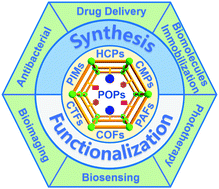
Chem. Soc. Rev., 2022,51, 1377-1414
https://doi.org/10.1039/D1CS00871D
A physicochemical introspection of porous organic polymer photocatalysts for wastewater treatment
A detailed physicochemical explanation for experimental observations is provided for POPs as powerful photocatalysts for organic transformations and wastewater decontamination.
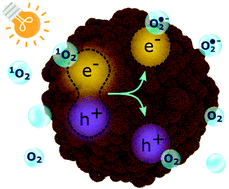
Chem. Soc. Rev., 2022,51, 1124-1138
https://doi.org/10.1039/D1CS00916H
Porous organic polymers for electrocatalysis
The application of porous organic polymers in various electrocatalytic reactions has been systematically summarized.
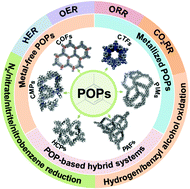
Chem. Soc. Rev., 2022,51, 761-791
https://doi.org/10.1039/D1CS00887K
Porous polyelectrolyte frameworks: synthesis, post-ionization and advanced applications
This review surveys approaches to the design and synthesis of emerging porous polyelectrolyte frameworks, and provides an overview of the recent advances in energy, environmental and biomedical fields.
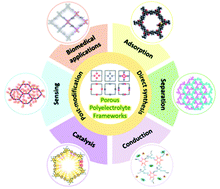
Chem. Soc. Rev., 2022,51, 237-267
https://doi.org/10.1039/D1CS00889G
Macrocycle-derived hierarchical porous organic polymers: synthesis and applications
This review article specifically highlights the synthetic strategies and promising applications of macrocycle-derived hierarchical porous organic polymers (POPs).

Chem. Soc. Rev., 2021,50, 11684-11714
https://doi.org/10.1039/D1CS00545F
Porous organic polymers for Li-chemistry-based batteries: functionalities and characterization studies
This tutorial review introduces different types of POPs and their classification and functions for Li-chemistry-based batteries. In situ characterization studies are also discussed to highlight their importance and applicability for POPs.
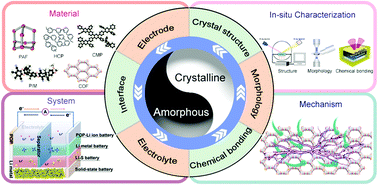
Chem. Soc. Rev., 2022,51, 2917-2938
https://doi.org/10.1039/D1CS01014J
Water-soluble and dispersible porous organic polymers: preparation, functions and applications
Water-solubility and dispersibility endow porous organic polymers with many valuable characteristics. This Tutorial review summarizes their preparation and diverse functions that are achieved mainly based on guest adsorption and loading in water.

Chem. Soc. Rev., 2022,51, 434-449
https://doi.org/10.1039/D1CS00862E
Post-synthetic modifications in porous organic polymers for biomedical and related applications
Porous organic polymers (POPs) are prepared by crosslinked polymerization of multidimensional rigid aromatic building blocks followed by PSM depending on the application.
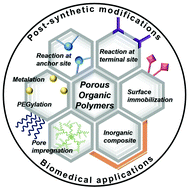
Chem. Soc. Rev., 2022,51, 43-56
https://doi.org/10.1039/D1CS00804H
Nanoscale porous organic polymers for drug delivery and advanced cancer theranostics
This tutorial review highlights the potential of nanoscale porous organic polymers in diagnosis and therapy of different types of cancers.
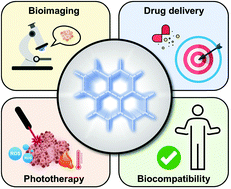
Chem. Soc. Rev., 2021,50, 12883-12896
https://doi.org/10.1039/D1CS00559F
About this collection
Porous Organic Polymers (POPs) are among the rapidly expanding research areas across various fields of science. These materials are advantageous because of their simple preparation methods, tunable structures, modular porosity, higher stability, and most suitable properties. Many advanced applications and techniques on crystalline and non-crystalline POPs are regularly reported across modern research areas ranging from biomedical, energy, environmental, and catalysis. Covalent organic frameworks are well represented in many recent reviews, but other POPs have been underrepresented.
This themed collection, Guest Edited by Chang Seop Hong (Korea University), Donglin Jiang (National University of Singapore), Jong Seung Kim (Korea University) and Guangshan Zhu (Northeast Normal University), comprises recent developments in porous organic polymers for advanced application strategies and prospects in various fields ranging from drug delivery and cancer theranostics, photocatalytic hydrogen evolution and carbon dioxide reduction, gas storages and separations, lithium-Ion battery, solar cells, encapsulation and sensing, water treatment and pollutant degradation, electrocatalysis, heterogeneous catalysis, photoredox catalysis for organic transformations etc.